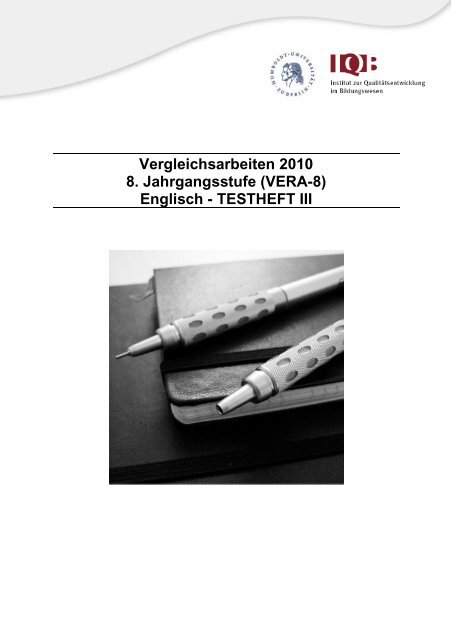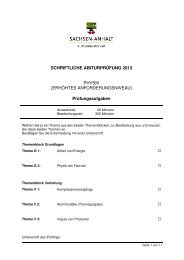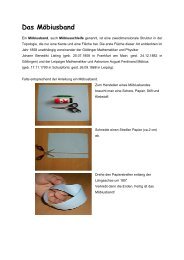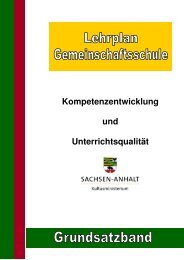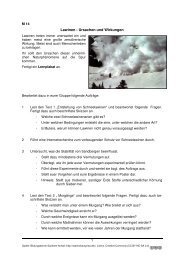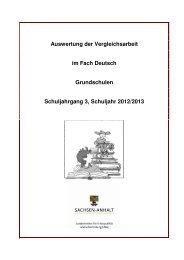Fragebogen für die Lehrkräfte der Fächer Mathematik, Englisch oder ...
Fragebogen für die Lehrkräfte der Fächer Mathematik, Englisch oder ...
Fragebogen für die Lehrkräfte der Fächer Mathematik, Englisch oder ...
Create successful ePaper yourself
Turn your PDF publications into a flip-book with our unique Google optimized e-Paper software.
Vergleichsarbeiten 2010<br />
8. Jahrgangsstufe (VERA-8)<br />
<strong>Englisch</strong> - TESTHEFT III
Anweisungen<br />
Du wirst in <strong>die</strong>sem Test verschiedene Aufgaben bearbeiten. Einige davon sind leicht,<br />
an<strong>der</strong>e sind schwer. Wenn du eine Aufgabe nicht lösen kannst, versuche <strong>die</strong> richtige<br />
Antwort zu erraten. Es können z. B. folgende Arten von Aufgaben vorkommen:<br />
Aufgaben mit Mehrfachauswahl / Multiple-Choice-Aufgaben<br />
Bei <strong>die</strong>sem Aufgabentyp werden verschiedene Antwortmöglichkeiten angeboten.<br />
Setze bei <strong>die</strong>sen Aufgaben ein Häkchen in das Kästchen, das vor <strong>der</strong> richtigen<br />
Antwort steht. Bei <strong>die</strong>sen Aufgaben ist immer nur eine <strong>der</strong> Antwortmöglichkeiten<br />
richtig!<br />
Beispiel 1:<br />
Joe Brown loves hunting bears, but he is getting old, and his eyes are not very<br />
good any more. Many times he almost shot a person instead of a bear.<br />
The text tells us that…<br />
0 Joe Brown loves bears.<br />
0 Joe Brown loves shooting people.<br />
Joe Brown is not very young.<br />
0 Joe Brown’s eyes are very good.<br />
Wenn du deine Antwort auf eine Frage än<strong>der</strong>n möchtest, streiche das Kästchen mit<br />
deiner ersten Antwort aus und setze ein Häkchen in das richtige Kästchen, so wie es<br />
in Beispiel 2 gezeigt wird.
Beispiel 2:<br />
Joe Brown loves hunting bears, but he is getting old, and his eyes are not very<br />
good any more. Many times he almost shot a person instead of a bear.<br />
The text tells us that…<br />
Joe Brown loves bears.<br />
0 Joe Brown loves shooting people.<br />
Joe Brown is not very young.<br />
0 Joe Brown’s eyes are very good.<br />
Zuordnungs-Aufgaben / Multiple-Matching-Aufgaben<br />
Bei <strong>die</strong>sem Aufgabentyp sollst du verschiedene Informationen einan<strong>der</strong> zuordnen<br />
und deine Antworten in eine Tabelle eintragen. Bei <strong>die</strong>sen Aufgaben ist immer nur<br />
eine <strong>der</strong> Antwortmöglichkeiten richtig! Bitte schreibe <strong>die</strong> Buchstaben deutlich und gut<br />
erkennbar.<br />
Beispiel 3:<br />
Match the countries (1 to 3) with the capitals (a to e). You may use each<br />
letter only once. There are two more capitals than you need.<br />
Write your answers in the table below.<br />
1. France a) Rome<br />
2. Germany b) London<br />
3. Italy c) Madrid<br />
1 2 3<br />
d e a<br />
d) Paris<br />
e) Berlin
Aufgaben mit Kurzantwort / Short-Answer-Aufgaben<br />
Bei <strong>die</strong>sem Aufgabentyp schreibst du deine Antwort auf. Halte dich dabei an <strong>die</strong><br />
angegebene Anzahl <strong>der</strong> Wörter, <strong>die</strong> du <strong>für</strong> deine Antwort verwenden darfst.<br />
Beispiel 4:<br />
What do you think about the story?<br />
It is interesting.<br />
Schreibaufgaben / Writing-Aufgaben<br />
Bei <strong>die</strong>sem Aufgabentyp schreibst du einen Text zu einem bestimmten Thema.<br />
Beachte <strong>die</strong> vorgegebene Mindestwortzahl; du kannst aber auch mehr schreiben.<br />
Beispiel 5:<br />
This summer you’ll be taking part in an exchange programme. Write a letter<br />
introducing yourself to your host family in Atlanta, USA.<br />
Hello,<br />
My name is Alex and I’m 14 years old…<br />
In <strong>die</strong> Bewertung von Schreibaufgaben gehen Inhalt, Textaufbau und <strong>die</strong> sprachliche<br />
Leistung (Wortschatz und Grammatik) ein.<br />
Viel Erfolg!
Lesen Teil I<br />
Es folgen jetzt Aufgaben zum Leseverstehen.<br />
Im Testheft findest du verschiedene Texte. Lies dir <strong>die</strong> Texte<br />
und <strong>die</strong> Arbeitsanweisungen durch und bearbeite dann <strong>die</strong><br />
Aufgaben zu jedem Text.<br />
Schreibe deine Antworten nur in <strong>die</strong> da<strong>für</strong> vorgesehenen Fel<strong>der</strong>.<br />
Für <strong>die</strong> folgenden Leseaufgaben hast du insgesamt 20 Minuten<br />
Zeit.
Aufgabe 1: The Caves of Nottingham<br />
Read the text taken from a leaflet. Then answer the questions below using<br />
1 to 5 words/numbers. Write feet, kilos, miles, years, minutes, etc. in your<br />
answers when needed. There is an example at the beginning (0).<br />
Discover a hidden world right beneath your feet in caves<br />
un<strong>der</strong> the streets of Nottingham and experience over 750<br />
years of history. Enter and explore the dark depths of<br />
these original Anglo-Saxon tunnels - meeting real cave<br />
dwellers from the dramatic past.<br />
Opening Times: Monday - Friday 10.30am to 5pm.<br />
Sat / Sun 10.30am to 5pm.<br />
Last admission 30 minutes before closing time.<br />
Admission Prices:<br />
Adults £5.50<br />
Children / Students / Senior Citizens £4.25<br />
Family £16.50<br />
(Families include two adults and two children or one adult<br />
and three children.)<br />
Un<strong>der</strong> 16s must be accompanied by an adult.<br />
Group Prices: Available on request<br />
1 in 12 goes free, for information regarding group<br />
bookings, please contact 0115 9520555 for details.
0. How old are the caves of Nottingham?<br />
1. When are they open at weekends?<br />
750 years<br />
2. When is the latest visitors can get in on a weekday?<br />
3. How much do students have to pay?<br />
4. How old must a person be to get in on his own?<br />
5. How many people do you need to get a free place?
Aufgabe 2: School on Air
a) Playing an instrument on air.<br />
b) Time teachers and pupils are on air together.<br />
c) Why the pupils of Mount ISA School are taught on air.<br />
d) Taking exams on air.<br />
e) Why the pupils love the time they are on air.<br />
f) How teachers and students communicate with each other.<br />
g) Things that are taught on air.<br />
0<br />
c<br />
1 2 3 4 5
Aufgabe 3: TV Programme<br />
You want to watch TV on the first day of your holidays. Look at the TV<br />
programme and answer the questions below in 1 to 5 words/numbers.<br />
There is an example at the beginning (0).<br />
BBC 1 ITV 1<br />
6.00<br />
AM<br />
9.15<br />
11.00<br />
DON’T FORGET – the new issue of WHAT’S ON is out tomorrow<br />
Breakfast<br />
News, business, sport<br />
Animal 24:7<br />
Wildlife documentary series<br />
Local News; Weather<br />
24 September MONDAY<br />
5.30<br />
AM<br />
9.00<br />
10.30<br />
Neighbours<br />
12.15 Australian TV series repeated at<br />
PM 5.30<br />
11.00<br />
1.00<br />
Doctors<br />
Medical drama series<br />
12.30<br />
PM<br />
3.25 CBBC/TV for Kids<br />
Starting with<br />
3.25 Bear Behaving Badly<br />
4.00 Shaun the Sheep<br />
4.15 Newsround for Kids<br />
5.00 New The Sarah Jane<br />
Adventures a new series<br />
3.00<br />
5.30 Neighbours<br />
repeated from 12.15<br />
4.15<br />
6.15 EastEn<strong>der</strong>s<br />
6.00<br />
TV series<br />
7.00<br />
Highland Clans<br />
MacGregor: 1 of 6<br />
The true stories behind the<br />
history of the Scottish Highland<br />
clans<br />
7.15<br />
8.00<br />
Perfect Friday<br />
Film: comedy<br />
9.00<br />
News and Features<br />
presented by Ben Shephard and<br />
Fiona Philipps<br />
The Jeremy Kyle Show<br />
Talk show<br />
Local News; Weather<br />
Loose Women<br />
Topical chat show<br />
Ready, Steady, Cook<br />
Eggheads<br />
Quiz<br />
ITV for Kids<br />
Starting with<br />
4.00 Big Cook Little Cook<br />
4.30 Tweenies Songtime<br />
5.00 Ethelbert the Tiger<br />
Sport<br />
Highlights of the weekend's<br />
Premier Leagues matches<br />
including the match between<br />
Manchester United and Arsenal<br />
Coronation Street<br />
Series<br />
New Doc Martin<br />
1 of 7 comedy drama series
0. You like watching news. When does Fiona Philipps present the news?<br />
at 5.30am<br />
1. You are interested in wild animals. Which programme can you watch?<br />
2. You want to watch a talk show. When can you do that?<br />
3. You are a fan of TV series. Which Australian series can you wach?<br />
4. You like quizzes. What is the name of a quiz show?<br />
5. You want to watch a new TV series for kids. When does it begin?<br />
6. You like come<strong>die</strong>s. What is the name of the new comedy drama series?
Aufgabe 4: Answer<br />
Read the text from an Internet notice board. Then answer the questions<br />
below using 1 to 5 words/numbers. Write feet, kilos, miles, years, minutes,<br />
etc. in your answers when needed. There is an example at the beginning<br />
(0).<br />
I'm 13 and I'd like to do a paper round. Can you tell me what it is like?<br />
Good grief, don't!<br />
I worked as a paper delivery person for a year and 8 months. It was hell! The<br />
pay is awful. I delivered 115 papers twice a week, had to put in up to 13<br />
leaflets in each... That's over 2,000 per week. The pay is very varied. It goes by<br />
weight of papers and leaflets. I usually got paid every fortnight – often less than<br />
£20. On my luckiest day it was £37, and my worst was £9. I wasted so much<br />
time; it takes about an hour and a half just to put the leaflets in. And then<br />
delivering them, rain or shine, takes another couple of hours, especially when<br />
the houses have long drives.<br />
Please, save yourself the pain... literally. It's so heavy.<br />
Oh, and you'll have to wait until you are 16 to work a Saturday job with decent<br />
pay. Sometimes you can work in bakeries or in Boots when you are 15.<br />
0. How long did the teenager work as a delivery person?<br />
1 year and 8 months<br />
1. How many papers did the teenager deliver per paper round?<br />
2. How many leaflets did the person put in the papers per week?<br />
3. How much money did the teenager get on his best day?<br />
4. How old must one be to work on Saturdays?
Aufgabe 5: Spaghetti<br />
Read the texts (0 to 5) and match them with one of the headings (a to g).<br />
You may use each letter only once. There is one more heading than you<br />
need. There is an example at the beginning (0).<br />
What to Do with Leftover Spaghetti?<br />
Prepare SPAGHETTI PANCAKE!<br />
(Serves four)<br />
0. You need: 3 cups spaghetti (cooked)<br />
4 eggs<br />
1 tsp salt<br />
1. Other things you can put in: fresh herbs<br />
tomatoes<br />
ham or bacon<br />
black pepper<br />
butter or oil (for frying)<br />
cheese<br />
onion or garlic<br />
2. In a large bowl beat the eggs until smooth. Add the spaghetti noodles and<br />
mix well. Mix in the salt and pepper and add any things you would like. Heat<br />
the oil or butter in a large frying pan.<br />
3. Pour the noodle mixture into the pan. Look un<strong>der</strong> the bottom from time to time<br />
and bake until the pancake begins to brown.<br />
4. Turn over by sliding it onto a plate and putting the frying pan on top. Turn it<br />
over. When both sides are slightly brown and the centre has firmed, turn out<br />
onto a plate.<br />
5. You can also make a hot breakfast out of leftover noodles with milk, sugar,<br />
and cinnamon, maybe vanilla.
Aufgabe 6: Cliff Rescue<br />
Read the text and decide what kind of text it is. Then tick the correct<br />
answer (a, b, c or d).<br />
Goat's Long Wait for Cliff Rescue<br />
A goat has been rescued from a sea cliff ledge on the Welsh coast after being<br />
stuck there for up to two weeks.<br />
It took rescuers more than two hours to abseil 60 metres down the cliff face to<br />
reach the animal at Great Orme, in Llandudno, and guide it back to safety.<br />
The animal's been surviving on patches of grass on the rocky ledge and seems<br />
to have survived without getting hurt.<br />
A rescue attempt earlier in the week had to be abandoned because it was too<br />
tricky to reach the goat.<br />
Fishermen were the first to raise the alarm when they spotted the goat on a<br />
ledge about 30 metres above the sea and realised it couldn't climb free.<br />
Mountain rescuers and the RSPCA were both involved in the rescue operation.<br />
The text …<br />
a) ...gives a journalist's opinion.<br />
b) ...reports factual information.<br />
c) ...is a short story.<br />
d) ...gives a rea<strong>der</strong>'s opinion.
Schreiben Teil I<br />
Es folgt jetzt eine Aufgabe zum Schreiben. Bei <strong>die</strong>ser Aufgabe<br />
sollst du einen Text zu einem bestimmten Thema schreiben.<br />
Lies dir <strong>die</strong> Arbeitsanweisung sorgfältig durch und schreibe<br />
dann deinen Text. In <strong>der</strong> Arbeitsanweisung steht, wie viele<br />
Wörter du ungefähr schreiben sollst.<br />
Denke daran, dass du insgesamt 20 Minuten hast. Plane deine<br />
Arbeit so, dass du Zeit zum Überarbeiten hast:<br />
Prüfe, ob du <strong>die</strong> Aufgabenstellung wirklich richtig erfasst hast<br />
und ob dein Text sinnvoll aufgebaut ist!<br />
Lies deinen Text zum Schluss noch einmal durch. Achte dabei<br />
auf mögliche Fehler! Sind <strong>die</strong> englischen Wörter sinnvoll<br />
gewählt, stimmt <strong>die</strong> Grammatik, stimmt <strong>die</strong> Rechtschreibung?<br />
Schreibe deutlich und leserlich!
Aufgabe: Celebrations<br />
Your partner school in Edinburgh wants to publish a series of articles<br />
about traditions in its school magazine.<br />
They are interested in knowing how you usually celebrate birthdays,<br />
Christmas or other festivals in your country.<br />
Choose one celebration you would like to describe.<br />
Write an article of 40 to 60 words.
Lesen Teil II<br />
Es folgen jetzt Aufgaben zum Leseverstehen.<br />
Im Testheft findest du verschiedene Texte. Lies dir <strong>die</strong> Texte<br />
und <strong>die</strong> Arbeitsanweisungen durch und bearbeite dann <strong>die</strong><br />
Aufgaben zu jedem Text.<br />
Schreibe deine Antworten nur in <strong>die</strong> da<strong>für</strong> vorgesehenen Fel<strong>der</strong>.<br />
Für <strong>die</strong> folgenden Leseaufgaben hast du insgesamt 20 Minuten<br />
Zeit.
Aufgabe 1: Feel Fabulous<br />
Look at the pictures (0 to 5) and match them with one of the texts (a to h).<br />
You may use each letter only once. There are two more texts than you<br />
need. There is an example at the beginning (0).<br />
0.<br />
3.<br />
0<br />
e<br />
1.<br />
4.<br />
a) Slowly breathe out, raising your arms to the sides and stopping at shoul<strong>der</strong><br />
height. Hold for a second then lower your arms as you breathe in.<br />
b) Lift your shoul<strong>der</strong>s as you slowly breathe in. Hold them up for a second<br />
keeping your arms at your side. Breathe out as you lower your shoul<strong>der</strong>s.<br />
c) Lie down (on a mat if you want) with your knees bent and feet flat. Put your<br />
hands behind your head (look at the ceiling).<br />
d) Look at the ceiling, lift your head and back, keeping your legs flat on the<br />
floor. Slowly breathe out.<br />
e) Breathe in and bend your knees into a squat position, keeping your knees in<br />
line with your toes and bottom tucked in. Squeeze your bottom cheeks and<br />
breathe out as you come up.<br />
f) Stand with feet 15cm apart, arms at your sides, and a 1.5kg weight (or tin of<br />
baked beans) in each hand.<br />
g) Stand with your legs about 60cm apart, your toes and knees turned out.<br />
h) Breathe out as you lift your head and shoul<strong>der</strong>s off the floor, keeping your<br />
lower back flat on the floor. Breathe in as you slowly lower.<br />
2.<br />
5.<br />
1 2 3 4 5
Aufgabe 2: Sydney Harbour Bridge<br />
Read the text and match the paragraphs (0 to 4) with the headings (a to f)<br />
below. You may use each letter only once. There is one more heading<br />
than you need. There is an example at the beginning (0).<br />
0. The Sydney Harbour Bridge is one of Australia's most well known and<br />
photographed landmarks. It is the world's largest (but not the longest) steel<br />
arch bridge with the top of the bridge standing 134 metres above the<br />
harbour. The Sydney Harbour Bridge celebrated its 70th birthday in 2002.<br />
1. The Sydney Harbour Bridge construction started in 1924 and it took 1,400<br />
men eight years to build it at a cost of £4.2 million. 53,000 tons of steel were<br />
used in its construction. It now carries eight traffic lanes and two rail lines,<br />
one in each direction, but at the time of its construction the two eastern<br />
lanes were tram tracks. They were converted to road traffic when Sydney<br />
closed down its tram system in the 1950s.<br />
2. When the bridge opened, it cost a horse and ri<strong>der</strong> three pence and a car six<br />
pence to cross. Now horses and ri<strong>der</strong>s cannot cross, but you can bicycle<br />
across in a special lane and walk across the bridge for free. Cars cost<br />
around $3.30 for a southbound trip and it is free to go northbound. In 1932,<br />
the average annual daily traffic was around 11,000 and now it is around<br />
160,000 vehicles per day.<br />
3. BridgeClimb started in 1998. After climbing through catwalks and up lad<strong>der</strong>s<br />
and stairs, the view is absolutely breathtaking. There are day, twilight and<br />
night climbs and a group of twelve will leave for a climb every ten minutes.<br />
The safety precautions taken include a blood alcohol reading and a climb<br />
simulator, which shows climbers the climbing conditions that might be<br />
experienced on the bridge.<br />
4. The Pylon Lookout is at the south-eastern end of the bridge (the Rocks end)<br />
and visitors can go to see an exhibition about the bridge and enjoy the<br />
spectacular 360° view from the top of the pylon, which is 89 metres above<br />
mean sea level.
Aufgabe 3: New Zealand<br />
Read the text. Then complete the table below using 1 to 5 words/numbers.<br />
There is an example at the beginning (0).<br />
It is possible to travel economically in New<br />
Zealand. Travellers can expect to get by on<br />
less than US$40.00 a day if camping or<br />
staying in hostels and self-catering. Motor<br />
camps and motels all have kitchens for<br />
guests' use, so staying in these also gives<br />
you the option of doing your own cooking.<br />
One of the main reasons people come to New Zealand is to participate in the<br />
activities the country is known for. Some cost nothing – tramping, swimming,<br />
bird watching – but as so many enjoyable activities are expensive, they can end<br />
up being a major part of your travel budget. If you stay in hotels, eat at<br />
restaurants and spend money on rafting, bungee jumping and the like, be<br />
prepared to outlay about US$100.00 a day.
Aufgabe 4: The Selfish Giant<br />
Read the paragraphs (a to h) from a fairy tale by Oscar Wilde. Then put<br />
them in the correct or<strong>der</strong> by completing the table below. There is one<br />
paragraph that you do not need. There are two examples (0 and 3). Start<br />
with paragraph d.<br />
a. When he arrived he saw the children playing in the garden.<br />
'What are you doing here?' he cried in a very unfriendly voice, and the<br />
children ran away.<br />
b. Birds sat on the trees and sang so sweetly that the children used to stop<br />
their games in or<strong>der</strong> to listen to them. 'How happy we are here!' they cried to<br />
each other.<br />
c. After the seven years were over he had said all that he had to say, for his<br />
conversation was limited, and he returned to his own castle.<br />
d. Every afternoon, as they were coming from school, the children used to go<br />
and play in the Giant's garden. It was a large lovely garden, with soft green<br />
grass.<br />
e. One day the Giant came back. He had been to visit his friend the Cornish<br />
ogre, and had stayed with him for seven years.<br />
f. Every afternoon, when school was over, the children came and played with<br />
the Giant. But the little boy whom the Giant loved was never seen again.<br />
g. 'My own garden is my own garden,' said the Giant; 'anyone can un<strong>der</strong>stand<br />
that, and I will allow nobody to play in it but myself.' So he built a high wall all<br />
round it. He was a very selfish Giant. The children had now nowhere to play.<br />
h. Here and there over the grass stood beautiful flowers like stars, and there<br />
were twelve peach-trees that in the spring time were covered with nice<br />
blossoms of pink and white, and in the autumn they were full of fruit.
Aufgabe 5: 'Britishness' Test
a) advantages b) applying c) bank<br />
d) compulsory e) designed f) expected<br />
g) fail h) introducing i) passed<br />
j) responsibilities k) role l) society<br />
m) write<br />
0 1 2 3 4 5 6 7 8<br />
d
Schreiben Teil II<br />
Es folgt jetzt eine Aufgabe zum Schreiben. Bei <strong>die</strong>ser Aufgabe<br />
sollst du einen Text zu einem bestimmten Thema schreiben.<br />
Lies dir <strong>die</strong> Arbeitsanweisung sorgfältig durch und schreibe<br />
dann deinen Text. In <strong>der</strong> Arbeitsanweisung steht, wie viele<br />
Wörter du ungefähr schreiben sollst.<br />
Denke daran, dass du insgesamt 20 Minuten hast. Plane deine<br />
Arbeit so, dass du Zeit zum Überarbeiten hast:<br />
Prüfe, ob du <strong>die</strong> Aufgabenstellung wirklich richtig erfasst hast<br />
und ob dein Text sinnvoll aufgebaut ist!<br />
Lies deinen Text zum Schluss noch einmal durch. Achte dabei<br />
auf mögliche Fehler! Sind <strong>die</strong> englischen Wörter sinnvoll<br />
gewählt, stimmt <strong>die</strong> Grammatik, stimmt <strong>die</strong> Rechtschreibung?<br />
Schreibe deutlich und leserlich!
Aufgabe: Keeper for a Day<br />
Read the poster below about a writing competition at LONDON ZOO.<br />
Do you want to be a<br />
KEEPER FOR A DAY?<br />
Do you want to be really close to our most popular animals?<br />
Would you like to find out about our keepers' day-to-day work?<br />
Then tell us which animal at our zoo you like best and why we should choose<br />
you.<br />
The ten nicest letters will win a day behind the scenes at our zoo.<br />
Write a letter to Mr George Lindsey, the head keeper, telling him …<br />
Write 110 to 140 words.<br />
…about your favourite animal at the zoo.<br />
…why you like this animal best.<br />
…what you would like to do as a keeper for a day.


